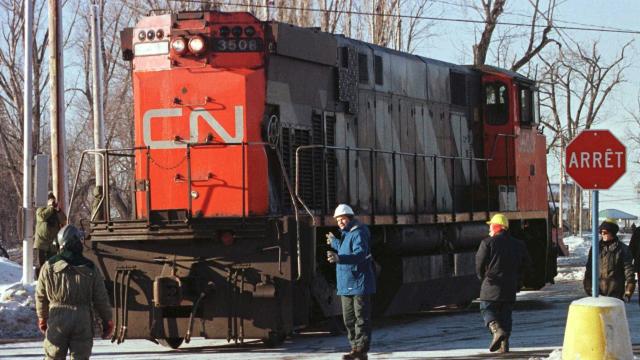Even in a suburb of Montreal that’s well versed in dealing with winter storms, inclement weather can still overwhelm basic services like power, an issue with which millions of people in Texas are still currently struggling. After an especially bad ice storm in 1998, the mayor of Boucherville, Quebec, had a clever idea to borrow a diesel-electric locomotive and use it as a super-sized emergency generator.
In most Canadian cities grabbing a snow brush and cleaning off your car before you can head to work in the morning is all part of enduring the winter months. In cities like Montreal, however, it’s not uncommon to have to first find your car in the morning after an overnight snowstorm leaves it completely buried. But, for the most part, snowstorms are mostly an inconvenience in northern Canadian cities, leaving side streets impassible until plows finish with major routes.
Ice storms, when temperatures result in freezing rain falling to earth instead of picturesque snowflakes, are a different story. The ice sticks to whatever it lands on and accumulates, often adding thousands of extra pounds of weight to trees or power lines and towers which eventually pushes them past their structural capacities until they collapse. That’s exactly what happened across parts of northeastern Canada over a week in January of 1998. Three successive ice storms brought down power lines and the towers supporting them that take much longer to fix, leaving over 1.5 million people without power in the middle of Winter.
A lack of power doesn’t just make it difficult for people to stay warm and feed themselves, it also makes it difficult for elected authorities and emergency personnel to plan and coordinate repairs and efforts to assist the people they represent. So while staring down endless questions about when power would potentially be restored, the mayor of Boucherville, Quebec, Francine Gadbois, came up with a clever plan to at least get the town’s city hall and emergency warming shelters up and running in the immediate future.
Modern locomotives run on diesel fuel instead of coal or wood as their steam-powered ancestors did, but the fuel is actually used to power onboard generators that create electricity to power the electric motors that actually drive the train’s wheels. In other words, modern locomotives are really just giant mobile generators, and Gadbois had recalled stories about them being used to provide power to small towns in rural northern Quebec several years prior. After some calls to the Canadian National Railway, the diesel locomotive M420W 3502 rolled into Boucherville to provide some much-needed assistance.
The rail line was close to the town’s city hall, but not close enough for this unusual application, so a crane was used to lift the diesel engine off its tracks and place it on Boulevard de Montarville. From there the locomotive completed the last 304.80 m of its journey rolling down the street under its own power while its extreme weight caused the train’s flanged wheels to cut deep tracks into the asphalt road which later had to be repaired.
Cables were run from the diesel engine to the nearby municipal buildings and its throttle was set to a speed which would produce roughly 375 kilowatts of power at 60 hertz (well below the locomotive’s maximum power of around 2,000 horsepower) which is the alternating frequency the North American power system runs on, and is what all of our electronics are expecting. The diesel engine produced enough electricity to power several municipal buildings at the same time allowing the local authorities to better organise their emergency and recovery planning.
A second locomotive was also brought in with the intention of using its output to power a local high school that was to be used as an emergency warming station for local residents. But getting to the shelter would have required the engine to cross an overpass, and it was eventually decided that there was a very good chance the overpass would collapse under the weight of a 117,934 kg locomotive, leaving the city with yet another emergency to deal with, and some concerned phone calls from the Canadian National Railway. As a result, it was left parked down the street on Boulevard de Montarville as an emergency backup.
When power was eventually restored to the region the two diesel engines were returned to the rails and put back to work hauling cargo, but not before being sent for repairs to damage caused to their gear cases after their unorthodox cruises through Boucherville.
As much as the city would have liked to keep the trains around for the next emergency (during their stay the locomotives also became quite a tourist draw with locals stopping by to have their pictures taken with the trains parked on the street) a diesel locomotive can cost well north of two million dollars and keeping one sitting idle “just in case” is a tough sell, especially when you’re borrowing someone else’s.
You can check out more photos from the Boucherville train adventure here.
